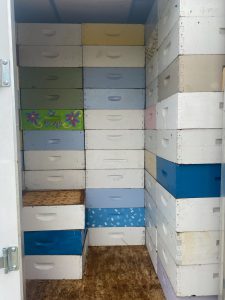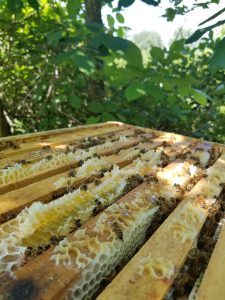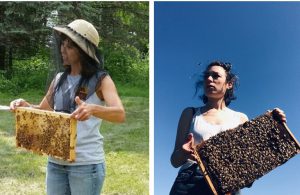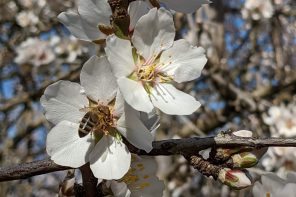Honey Time: Part 1
By: Becky Masterman & Bridget Mendel
When Dr. John sings, “I been in the right place/But it must have been the wrong time,” he probably isn’t singing about beekeeping, but he sure sounds like a beekeeper griping about missing the nectar flow. We spent part of our Summer asking beekeepers to share their best advice on how to make a great honey crop. The first thing many beekeepers mention is being in the right place. Putting your bee near lots of good forage is key, but the right place won’t yield honey with the wrong timing. As Gary Reuter famously sang, “You can’t make honey if the supers are in the shed.”
Honey production is all about wedging your bees into the space/time continuum exactly right, and that takes practice, and practice takes years. We asked two, fourth generation beekeepers whose family businesses are now powered by the fifth generation what advice they would share with you. “Lessons of bee health and management timing are repeated until they are learned,” advised beekeeper and current president of the North Dakota Beekeepers Association, John Miller. Prior to retirement, John led Miller Honey Farms and their million-pounds-plus honey crop each year. His brother, Jay, Vice President of the American Beekeeping Federation and owner of 2J Honey Farms skipped to the punchline by quoting Carl Powers of Powers Apiaries, the biggest honey business around in 1960s, “Do what you should do when you should do it.”
Doing what you should do when you should do it takes practice. And part of the practice of beekeeping is being flexible and ready for strange seasons and disagreeable weather patterns. A late Spring, a wet Summer or a dry spell can affect the timing or abundance of nectars, our management choices and ultimately honey production. Though they chewed over weather plenty, none of the beekeepers we talked to had any good tips on negotiating with the weather gods.
Getting good honey also takes investing in the apiary and the surrounding landscape. Dr John sang, “I took the right road/But I must have took a wrong turn.” We took this lyric to refer to Dr. John’s fantasy of working with a commercial beekeeper. Locating beekeepers’ well-hidden apiaries is not a problem for the team of multi-talented Bee Informed Partnership (BIP) technicians. The BIP program, in whom many commercial beekeepers invest in to track mites and diseases in their operations, supports honey production by catching health problems while they can still be solved. You can get your supers out of the shed early and onto colonies, but if your bees are dying of mites and viruses they won’t fill up.

Supers “not making honey” while in the shed.
Photo Credit: Bridget Mendel
Beekeepers of all operation sizes emphasized the importance of keeping bees healthy, including monitoring and managing mites for productive bees. Some brought up the importance of new queens. Requeening in Spring is a practice that guarantees “fresh” queens: young, well-mated queens tend to be pretty productive, and more brood production means—you guessed it—a big population just in time for the basswood flow.
When asked to share honey production tips with Bee Culture readers, the beekeepers’ generous nature and willingness to help each other was evident. We hope you enjoy the following beebliography of honey production wisdom.
Meghan Milbrath, Assistant Professor in Michigan State’s Department of Entomology and owner of Sand Hill Bees: Put on supers early and often.
James Hillemeyer, owner of L. B. Werks, a honey and pollination business: Bring your (queen) operation in house. You get bigger honey crops with fresher queens. Time your population increase with the nectar flow.
Doug Ruby, owner of Ruby’s Apiaries, Inc. and commercial beekeeper in Minnesota and Texas: You need strong bees, good sub soil moisture and temperatures and a little luck.
Dan Whitney, owner of Whitney Lone Star Queen Co. and Dan’s Honey Co., beekeeper in Minnesota and Texas: You need a strong back, healthy bees and weather a little on the dry side.

A honey super being filled with fresh nectar, bees working on capping it.
Photo Credit: Rebecca Masterman
Dave Hackenberg, founder of Hackenberg Apiaries: You need the right kind of weather and to be on time.
Gary Honl, former owner of Honl’s Bees in Minnesota and Texas: You need the right location and habitat.
Dave Schroeder, Past President of the Minnesota Honey Producers Association and beekeeper in Minnesota and Wisconsin: Make sure there is good bee forage. Don’t be afraid to invest with the landowner.
Bob Sears, beekeeper in Missouri, national bee health advocate: Requeen every year with good queens, treat for mites, and super early.
Ryan Lamb, co-owner Lamb’s Honey Farm, commercial beekeeper in Texas and North Dakota: Add an extra pollen patty in the Spring.
Mark Sundberg, current president of the Minnesota Honey Producers Association, beekeeper in Minnesota and Mississippi, and owner of Sundberg Apiaries, Inc.: Be in the right place. Location and weather are important. You need good, strong, well fed and healthy hives.
Ang Roell, founder of They Keep Bees in Massachusetts: In our operation we let hives grow up on early flows then initiate a walk-away split. This gives them an extended brood break and they yield a nice honey crop while they’re making their new queen. It keeps our apiary genetics diverse and allows us to integrate both IPM & honey production in our queen breeding operation.

Becky Masterman led the UMN Bee Squad from
2013-2019. Bridget Mendel joined the Bee Squad in 2013 and has led the program since 2020. Photos of Becky (left) and Bridget (right) looking for their respective hives. If you would like to contact the authors with your own honey production tips or other thoughts, please send an email to
mindingyourbeesandcues@gmail.com
Stay tuned for Part 2 next month where we dive into some of the science behind a good honey crop and tell you why beekeepers are some of the best botanists around.
Acknowledgments
The authors would like to thank Dr. Marla Spivak for helpful edits and suggestions and John Miller for his history lesson on Powers Apiaries.








